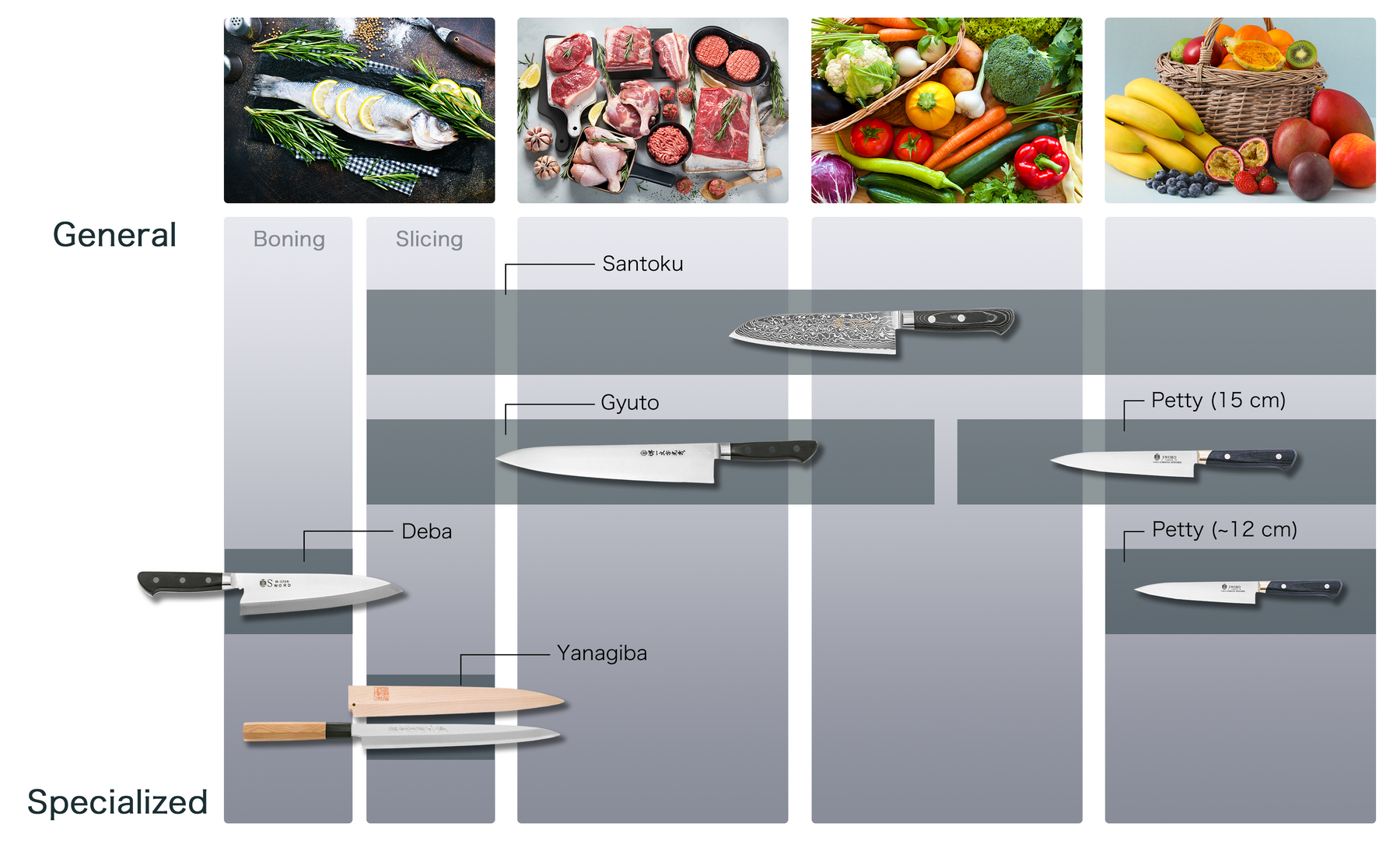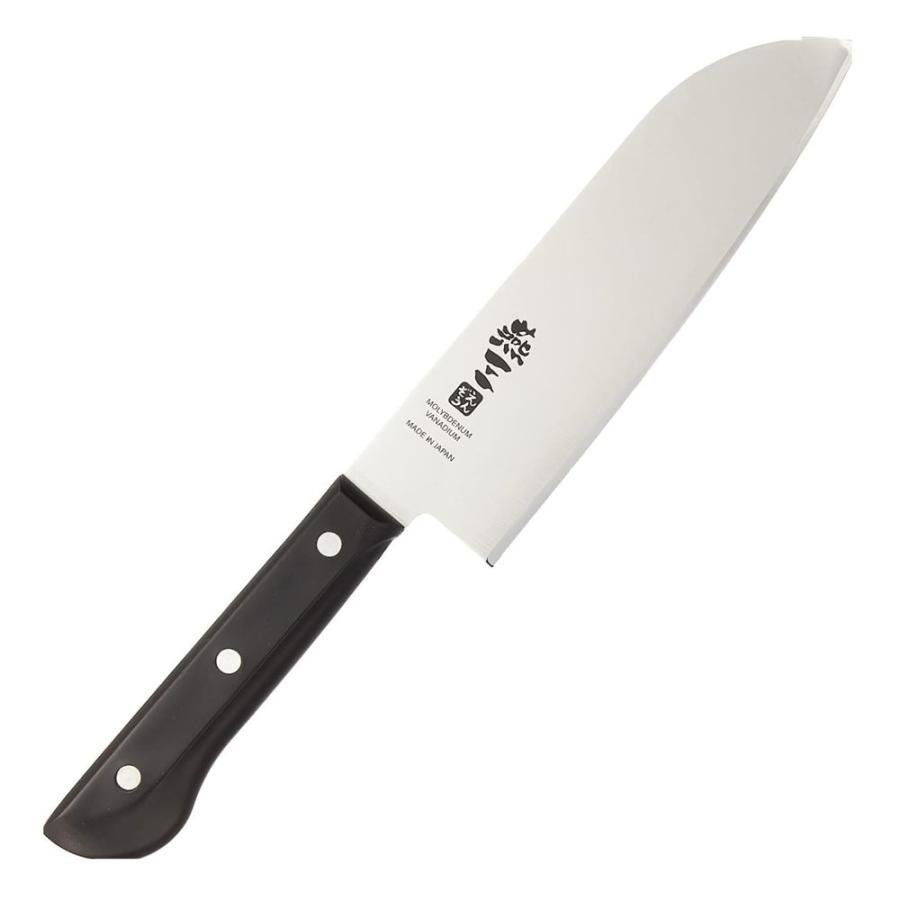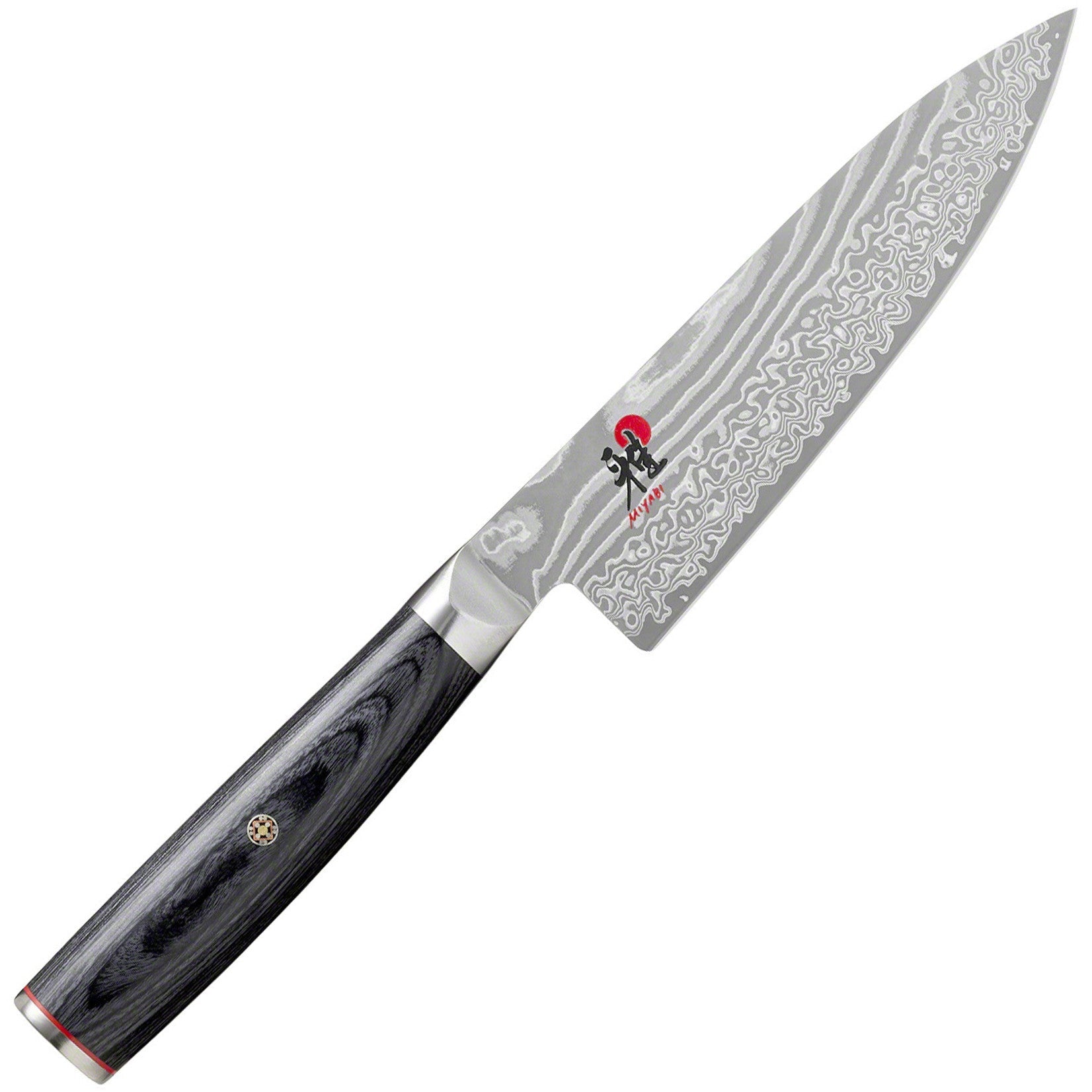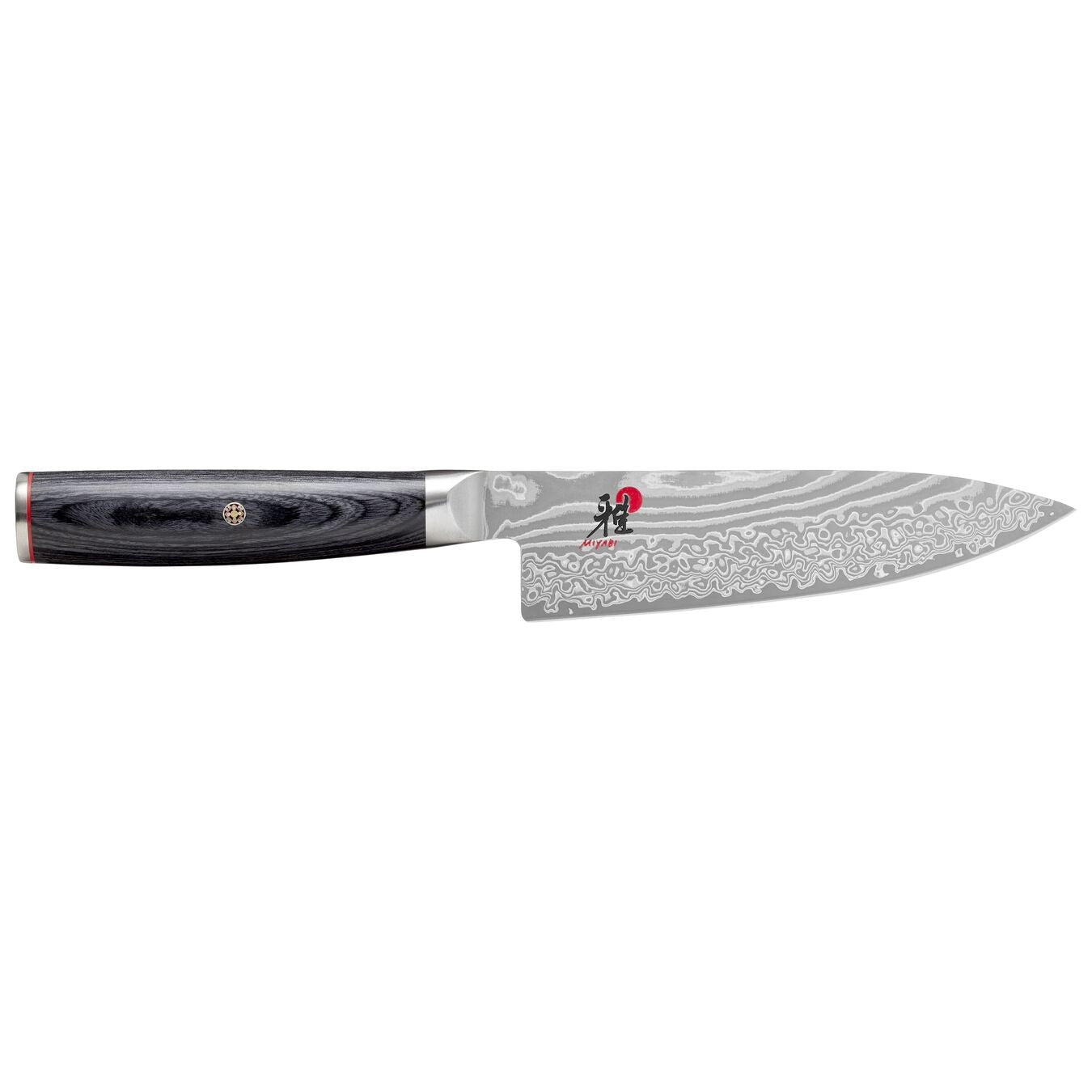Introduction
Choosing the right Japanese chef’s knife is crucial for both professional chefs and home cooks. Japanese knives are renowned for their precision, sharpness, and craftsmanship, making them an essential tool in any kitchen. This guide will help you understand the different types of Japanese knives, key features to consider, tips for maintenance, and recommendations for top brands.
Understanding Japanese Chef’s Knives
History and Tradition
Japanese chef’s knives have a rich history rooted in the country's sword-making traditions. The craftsmanship of these knives has been perfected over centuries, combining ancient techniques with modern technology to produce blades of exceptional quality. These knives are not just tools; they are a testament to Japan’s dedication to artistry and precision. Understanding this historical context helps appreciate the value and uniqueness of Japanese chef's knives.
Types of Japanese Chef’s Knives

Santoku
The Santoku knife is a versatile all-purpose knife known for its shorter, more compact blade, making it ideal for chopping, slicing, and dicing. The name "Santoku" means "three virtues," referring to its proficiency in three key tasks: slicing, dicing, and mincing. This knife is perfect for home cooks who need a reliable and versatile tool for everyday cooking.
Gyuto
The Gyuto knife is similar to the Western chef’s knife but with a thinner and sharper blade, perfect for cutting meat and vegetables with precision. It is often the go-to knife for professional chefs due to its versatility and sharpness. The Gyuto is designed for both push and pull cutting techniques, making it a favorite in busy kitchens.
Nakiri
The Nakiri knife is designed for chopping vegetables. Its straight edge allows for clean, even cuts without the rocking motion typical of Western knives. This knife is particularly useful for cutting hard vegetables like carrots and squash, as well as leafy greens and herbs. The Nakiri’s design ensures minimal bruising of delicate vegetables, preserving their freshness and flavor.
Deba
The Deba knife is a heavy-duty knife used for filleting fish and cutting through small bones and cartilage. Its thick, robust blade can handle tough tasks that would damage other knives. The Deba is essential for those who frequently prepare fish, offering precision and strength for filleting and butchering.
Yanagiba
The Yanagiba knife is traditionally used for slicing raw fish for sushi and sashimi. Its long, narrow blade ensures clean, precise cuts, essential for presenting beautifully sliced fish. The Yanagiba is a must-have for sushi chefs and enthusiasts who value the aesthetics and precision of Japanese cuisine.
Differences Between Western and Japanese Knives
Blade Design and Edge
Japanese knives typically have a sharper and more refined edge compared to Western knives, which often have a thicker, more durable blade. The sharper edge of Japanese knives allows for precise cuts and a smoother cutting experience. However, this also means they require more careful handling and maintenance to prevent chipping and dulling.
Handle Style and Materials
Japanese handles (Wa-handle) are often lighter and made from materials like wood, providing a different balance and feel compared to Western handles (Yo-handle), which are typically heavier and made from synthetic materials. The choice between these handle styles depends on personal preference and the type of tasks being performed.
Purpose and Functionality
Japanese knives are often designed for specific tasks, while Western knives are generally more versatile. Understanding these differences helps in selecting the right knife for your cooking needs. Japanese knives are specialized tools, each crafted for a specific purpose, enhancing the cooking experience through precision and efficiency.
Key Features to Consider
Blade Material
High-Carbon Steel vs. Stainless Steel
High-carbon steel blades are sharper and easier to sharpen but require more maintenance to prevent rust. Stainless steel blades are more resistant to rust and stains but may not retain sharpness as long. The choice between these materials depends on your willingness to maintain the knife and your preference for sharpness versus durability.
Damascus Steel
Damascus steel knives are known for their distinctive layered patterns and superior durability and sharpness. The unique wavy patterns on the blade are not just for aesthetics; they also contribute to the knife's strength and ability to hold a sharp edge. Damascus steel is often a sign of high-quality craftsmanship and performance.
Blade Edge
Single Bevel vs. Double Bevel
Single bevel knives are sharpened on one side, making them extremely sharp but challenging to use for some tasks. Double bevel knives are sharpened on both sides, offering more versatility. The single bevel is typical for traditional Japanese knives used for specific tasks like slicing sashimi, while double bevels are more common in Western-style knives for general use.
Edge Retention and Sharpness
Consider the knife’s ability to retain its edge over time and how often it will need sharpening. High-quality Japanese knives, especially those made from harder steels, tend to retain their sharpness longer but may require professional sharpening techniques to maintain.
Knife Handle
Traditional Japanese Handles (Wa-handle) vs. Western Handles (Yo-handle)
Wa-handles are lighter and often made from wood, providing a different balance and feel. Yo-handles are typically heavier and made from synthetic materials. The choice between these handle styles depends on personal preference and the type of tasks being performed. Wa-handles offer a traditional look and feel, while Yo-handles provide a more familiar grip for those used to Western knives.
Materials Used (Wood, Composite, Plastic)
The handle material affects the knife's grip, balance, and durability. Wood handles offer a natural feel and aesthetic but require more maintenance to prevent cracking and drying out. Composite and plastic handles are more durable and resistant to moisture, making them easier to maintain.
Knife Balance and Weight
A well-balanced knife ensures comfort and precision during use. The right weight depends on personal preference and the type of tasks performed. Some cooks prefer a heavier knife for its power and stability, while others prefer a lighter knife for its agility and ease of use.
How to Choose the Right Knife for You
Assessing Your Cooking Style
Match the knife type to your cooking tasks. For example, a Santoku or Gyuto is great for general purposes, while a Nakiri is perfect for vegetables. Consider the types of dishes you prepare most often and choose a knife that complements your cooking style.
Budget Considerations
Determine your budget and balance cost with quality. Japanese knives range from affordable options to high-end, professional-grade knives. Investing in a higher-quality knife can offer better performance and longevity, but there are also excellent options available for those on a tighter budget.
Trying Before You Buy
Test the knife in person if possible. Check for comfort, balance, and how it feels in your hand. Many stores offer the opportunity to handle and test knives, which can provide valuable insight into which knife feels best for you.
Maintenance and Care Tips
Proper Cleaning and Storage
Hand Washing vs. Dishwasher
Always hand wash your Japanese knives to maintain their sharpness and prevent damage. Avoid dishwashers as they can cause corrosion and dulling. Use warm water and mild detergent, and dry the knife immediately to prevent rust.
Safe Storage Options
Store knives in a knife block, magnetic strip, or sheath to protect the blade and ensure safety. Proper storage prevents the blade from getting damaged and keeps the knife readily accessible for use.
Sharpening Your Japanese Knife
Sharpening Stones and Techniques
Use sharpening stones (whetstones) to maintain the knife’s edge. Learn the correct technique to ensure consistent sharpness. Regular honing with a steel rod can also help maintain the edge between sharpening sessions.
Frequency of Sharpening
Regular sharpening is essential to keep your knife performing at its best. The frequency depends on usage and the type of knife. Professional chefs may sharpen their knives weekly, while home cooks may only need to sharpen them a few times a year.
Avoiding Common Mistakes
Cutting on Improper Surfaces
Use a wooden or plastic cutting board to prevent dulling the blade. Avoid glass, stone, or metal surfaces, as they can quickly damage the edge.
Using the Knife for Incorrect Tasks
Do not use your Japanese chef’s knife for tasks it’s not designed for, such as opening cans or cutting through frozen food. Using the knife improperly can damage the blade and reduce its lifespan.
Top Recommendations for Japanese Chef’s Knives
:max_bytes(150000):strip_icc()/SES-Renu-Japanese-Knives-5-Renu-Dhar.jpg-135f08f4793b456589cefcf5dc70f9e7.jpg)
Best Overall Japanese Chef’s Knife
Features and Benefits
Look for a knife that offers a balance of sharpness, durability, and comfort. Consider reputable brands with a history of quality craftsmanship. Some top brands include Shun, Global, and Miyabi.
Why It Stands Out
Highlight unique features, such as blade material, edge retention, and user reviews. A knife that consistently receives high marks for performance and longevity is a good investment.
Best Budget Japanese Chef’s Knife
Affordable Options Without Compromising Quality
Identify knives that provide excellent value for money, balancing affordability and performance. Brands like Tojiro and Mac offer high-quality knives at more accessible price points.
Best High-End Japanese Chef’s Knife
Premium Choices for Enthusiasts and Professionals
When it comes to high-end Japanese chef's knives, you're looking for unparalleled quality, craftsmanship, and performance. These knives are often hand-forged by skilled artisans using traditional techniques that have been perfected over centuries. The attention to detail in these knives ensures not only exceptional sharpness but also durability and balance, making them a prized possession for any serious cook or professional chef.
Masamoto Masamoto is one of the most respected names in Japanese cutlery, with a history dating back over 150 years. Known for their high-quality steel and meticulous craftsmanship, Masamoto knives are a favorite among professional chefs worldwide. The Masamoto KS series, in particular, is highly acclaimed for its superior balance, edge retention, and ease of sharpening. These knives are typically made from high-carbon steel, which allows for an exceptionally sharp edge, though it requires regular maintenance to prevent rust.
Yoshihiro Yoshihiro knives are synonymous with traditional Japanese knife-making excellence. With over a century of experience, Yoshihiro produces knives that are both beautiful and functional. Their high-end knives often feature Damascus steel, known for its intricate patterns and exceptional strength. The Yoshihiro Mizuyaki Honyaki series, for instance, is crafted from a single piece of high-carbon steel and undergoes a special water-quenching process, resulting in a blade that is incredibly sharp and durable. These knives are often handcrafted, making each one unique.
Shun Shun knives, produced by the Kai Group, are known for blending traditional Japanese techniques with modern technology. The Shun Premier and Shun Classic series are highly regarded for their VG-MAX steel cores and Damascus-clad blades, providing both beauty and functionality. These knives are designed to maintain their sharpness over extended periods and are often recommended for professional kitchens due to their reliability and performance.
Miyabi Miyabi knives, part of the Zwilling J.A. Henckels family, combine German engineering with Japanese artistry. The Miyabi Black 5000MCD series, for example, is renowned for its use of MicroCarbide powder steel, which allows for an extremely fine and sharp edge. The ice-hardening process these knives undergo enhances their durability and edge retention. Miyabi knives also feature traditional D-shaped handles, providing a comfortable grip for precision cutting.
Why High-End Japanese Knives Stand Out High-end Japanese knives stand out due to their exceptional craftsmanship, which often involves hand-forging, layering different types of steel, and meticulous attention to detail. These knives are designed to perform at the highest level, offering unparalleled sharpness, balance, and durability. The materials used, such as high-carbon steel and Damascus steel, are chosen for their superior edge retention and cutting performance. Additionally, the aesthetic beauty of these knives, often featuring intricate patterns and elegant designs, makes them not only tools but also works of art.
Best Japanese Knife for Beginners
User-Friendly Options for Those New to Japanese Knives
For those new to Japanese knives, selecting a user-friendly option that balances performance with ease of use is crucial. Beginners should look for knives that are versatile, easy to maintain, and reasonably priced. Here are some excellent choices that cater to novice users:
Global G-2 The Global G-2 chef’s knife is a fantastic entry point for those new to Japanese knives. Made from Cromova 18 stainless steel, it offers a sharp edge that retains its sharpness well over time. The knife’s lightweight and well-balanced design make it easy to handle, while its unique stainless steel handle with dimples ensures a secure grip. The Global G-2 is versatile enough for a wide range of kitchen tasks, making it a great all-purpose knife for beginners.
Shun Classic Santoku The Shun Classic Santoku knife is another excellent choice for beginners. Featuring a VG-MAX steel core with 34 layers of Damascus cladding on each side, this knife combines sharpness with durability. The Santoku’s shorter, wider blade is ideal for chopping, slicing, and dicing, providing a comfortable and efficient cutting experience. The D-shaped PakkaWood handle is designed to fit comfortably in the hand, reducing fatigue during prolonged use. Additionally, Shun’s lifetime free sharpening service makes maintaining the knife easy for new users.
Tojiro DP Gyuto The Tojiro DP Gyuto is an affordable yet high-quality option for beginners. It features a VG-10 steel core with a stainless steel cladding, offering a sharp edge that is easy to maintain. The knife’s Western-style handle provides a familiar grip for those transitioning from Western knives, and its balanced design makes it comfortable to use. The Tojiro DP Gyuto is versatile and suitable for a variety of kitchen tasks, making it an ideal starter knife.
Mac Professional Series The Mac Professional Series chef’s knife is praised for its excellent balance and sharpness. Made from high-carbon stainless steel, it retains its edge well and is relatively easy to sharpen. The knife’s slightly curved blade allows for a rocking motion, which is beneficial for those accustomed to Western-style cutting techniques. The PakkaWood handle provides a comfortable grip, making it a user-friendly option for beginners.
Why These Knives are Ideal for Beginners These knives are recommended for beginners due to their balance of performance, ease of maintenance, and affordability. They offer sharp, durable blades that can handle a variety of kitchen tasks, helping new users develop their skills and confidence in using Japanese knives. The handles are designed for comfort and secure grip, reducing the learning curve associated with transitioning to Japanese knives. Moreover, their reasonable price points make them accessible for those looking to start their collection without a significant investment.
Frequently Asked Questions (FAQs)
-
What is the best Japanese knife for home cooks?
- Provide a recommendation based on versatility and ease of use. The Santoku or Gyuto are often the best choices for home cooks due to their all-purpose nature.
-
How do I maintain the sharpness of my Japanese knife?
- Explain proper sharpening techniques and maintenance tips, including regular honing and using whetstones for sharpening.
-
Can I use a Japanese knife for all types of cooking?
- Discuss the versatility of different types of Japanese knives and their specific uses. While some knives are specialized, others like the Gyuto and Santoku can handle a wide range of tasks.
Conclusion
Choosing the right Japanese chef’s knife involves understanding the different types, key features, and proper maintenance. By considering your cooking style, budget, and preferences, you can find the perfect knife to enhance your culinary experience. Invest in a quality Japanese knife, and it will serve you well for years to come. A well-chosen Japanese chef’s knife not only improves your cooking efficiency but also adds an element of artistry and precision to your culinary endeavors.

















